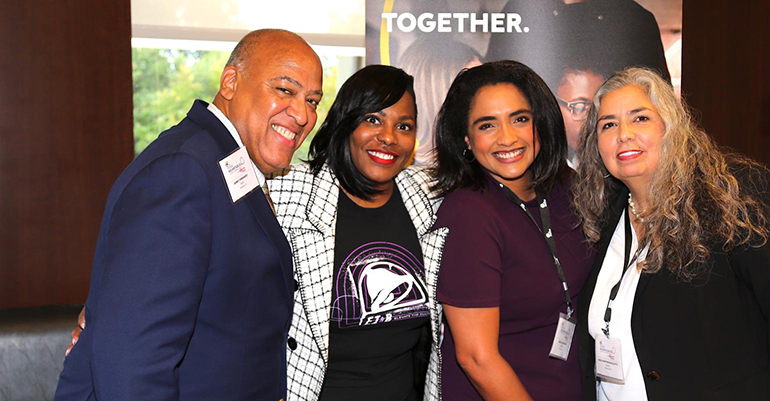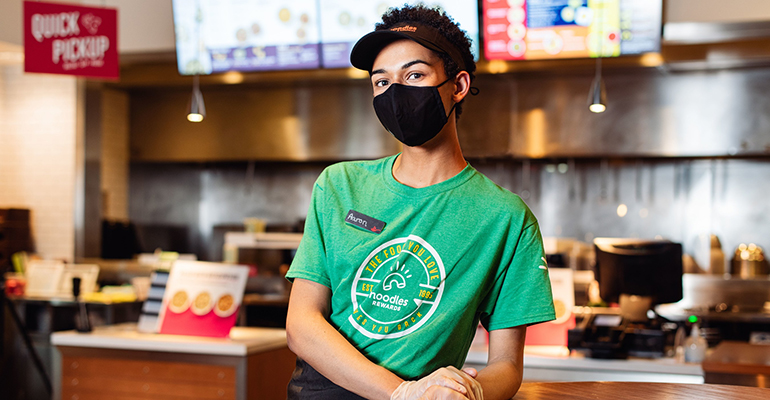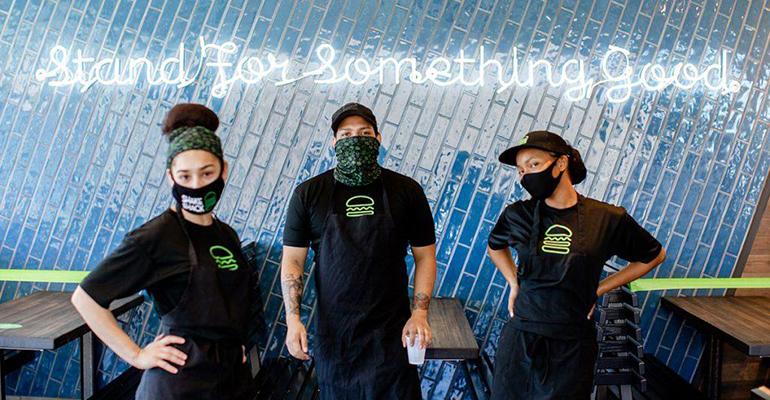In August, the Prosper Forum was held for the first time with an objective of elevating the future of diverse talent within the foodservice and hospitality industry. As cofounder and CEO David Jobe noted, having diverse decision makers in place not only better reflects the industry’s workforce and consumers, but it is also good for business and ensures its long-term success.
Notably, the event took place in Florida amid a tumultuous time for diversity, equity, and inclusion efforts. Just months prior, the state’s so-called “Don’t Say Gay” bill was signed by Governor Ron DeSantis, while the United States Supreme Court ruled against affirmative action programs in college admissions, and a bevy of consumers outwardly boycotted Bud Light and Target for embracing inclusive messaging.
It seems a societal pendulum is swinging in an opposite direction as it was during the summer of 2020, when brands across industries released statements and promised ambitious commitments toward improving DEI within their companies following the murder of George Floyd.
Are restaurant brands upholding their promises? That may depend on who you ask.
“There are a lot of people who want this genie to go back into the bottle. There is now a cost to being heard on this and what we call ‘diversity fatigue,’” said Gerry Fernandez, president and founder of the Multicultural Foodservice and Hospitality Alliance (MFHA). “There were many companies who jumped on the bandwagon after the George Floyd murder, and it may have been a bit performative. As soon as headwinds come, you see departments and positions being eliminated, or VP-level positions being quietly downgraded. It’s happening in our industry, too. Although we’ve made progress forward, too many have become crickets.”
But hospitality companies should be especially committed to DEI, he said. Consider the restaurant industry’s workforce, for example. On the employment side, 49% of restaurant and foodservice employees are minorities, compared to 38% of employees in the total U.S. employed labor force; 25% of restaurant employees are Hispanic, 13% are Black or African American, and 7% are Asian. Each of these groups have a larger representation in the industry than they do in the overall U.S. workforce, according to data from the National Restaurant Association.
Further, according to Randstad’s 2023 Workmonitor report, today’s workforce, particularly Gen Z and millennials, values diversity and inclusion more than ever (87%), while a majority of respondents, 54%, said they would quit if they didn’t sense they belonged at their company. As the industry continues to grapple with recruitment and retention issues, striving for representation is a good place to start on a solution.
Gerry Fernandez, left, president and founder of the Multicultural Foodservice and Hospitality Alliance, said brands should engage all key stakeholders in DEI work. 
However, it’s clear that much work remains. According to the National Restaurant Association’s 2022 DEI study — the association’s most recent report on the topic — more than one-third of current industry employees are looking for other jobs and just 16% expect those new jobs to be in restaurants or foodservice. Further, the report shows that 64% of restaurant employees “strongly agree” that their company offers career pathways, but just 35% say their company provides good long-term opportunities. Female, Hispanic, and Black employees rated their companies poorer than white and male employees.
According to AlixPartners, the macroeconomic shift toward services is creating a “pivotal, disruptive” moment for employment, and one restaurants must reconcile.
“The sector that has historically positioned itself to target a transient or entry-level labor force will need to shift to robust career development,” an AlixPartners report stated. “The evolution of the industry will require further investment in diversity, equity and inclusion by leading concepts.”
Closing the gap
That investment presents a compelling business case, said Bryce Fluellen, president and cofounder of Arthur Lee Consulting & Advisory.
“When I think about frontline workers in this industry especially, what I’ve seen is they predominantly come from disadvantaged backgrounds of color. If you want to grow your brand and don’t make investments in those people, they’re going to go somewhere else. The same is true if they don’t see people in leadership that look like them,” Fluellen said. “It’s important as a business to understand we all come from different backgrounds and experiences and that power of diversity helps you foresee a lot of things you wouldn’t otherwise see.”
Indeed, research from McKinsey & Company finds that companies with more than 30% women executives were more likely to outperform companies with lower representation. The same is true for companies with greater ethnic and cultural diversity.
That said, some companies are making more progress on this work than others. Noodles & Company, for instance, has been recognized by Forbes and Newsweek as one of the best employers for diversity. In 2021, the company doubled down on its DEI efforts by signing the CEO Action for Diversity & Inclusion pledge, committing to a variety of actions to create a more inclusive workplace, such as the implementation of unconscious bias training, engaging the board of directors on inclusion and diversity strategies, and sharing best practices around diversity and inclusion.
“Additionally, we set up a dedicated Inclusion & Diversity Advisory Council and established a DEI newsletter, listening forums, and inbox to receive real-time feedback from our team members,” said Sue Petersen, EVP of HR, Inclusion & Diversity, and Total Rewards. “Our goal continues to be to make Noodles the best place for our team members to work with a strong focus on DEI.”
Notably, Noodles also introduced new team member benefits in 2022 to better support a diverse workforce, such as immigration reimbursement; a general manager equity partner program; a reimbursement program tied to mental, financial and physical wellbeing; and Noodles Resource Groups. Petersen said the company has received a “tremendous response” from employees who have utilized these benefits, and the culmination of these efforts has started to pay off.
Noodles & Company has been recognized by Forbes and Newsweek as one of the best employers for diversity. The company has committed to a variety of actions to create a more inclusive workplace.
“We have seen improvement in the underrepresented communities over the past several years, with our (Black, Indigenous, People of Color) representation increasing by almost 15%. Additionally, we have a strong LGBTQIA+ community, with approximately 25% of our team members identifying as a part of this community,” Petersen said. “We still have work to do, but have seen an increase in representation at all levels. We always want to hire, promote, celebrate the best team members, and we ensure this by always including a diverse slate of individuals to consider.”
Denny’s is another company that has long prioritized DEI. During the Prosper Forum, CEO Kelli Valade said the chain committed to improving its practices in 1994 after settling a discrimination lawsuit and continues to evolve and expand its efforts today.
“The numbers stand for themselves. We have eight business resource groups; each has their own budget, an executive sponsor, a chair. We do countless things for our communities. Our board is 62% people of color and 62% women,” she said.
Denny’s also has programs in place such as Denny’s Together, a 30-day immersion program where employees practice on-the-job application of its DEI policy. Employees are also tasked with learning Denny’s “Rules to Live By,” through eLearning, videos and more. This is just a glimpse of what is offered, and the leadership team is very much involved in all of it.
“[The work] is wide, it’s deep and it is a part of what we do every day. But there’s more to do,” Valade said.
Shake Shack has also prioritized DEI since its beginnings as a hot dog cart in 2001, particularly through its “Stand For Something Good” commitment. Idris Stover, director of diversity, equity, inclusion and engagement, said that by the end of 2025 the company aims to have 50% of leadership roles and 30% of home office leadership held by people of color. Shake Shack is also striving toward gender parity. To help achieve these goals, the company launched Shift Up in 2020 to prepare and empower employees to “shift up” their career level. The 18-week paid program allows entry-level managers to enhance their professional skills with the goal of eventual promotion.
In 2022, Shake Shack announced more than 2,600 internal promotions, with 55% going to women and 77% going to people of color. Stover said the company is doubling down this year on the talent side, with a sharpened focus on recruiting, rewarding, and retaining its team members.
“We believe it’s key that we have a diverse team, help leaders foster great work environments, and provide opportunities for our team members to grow and advance,” she said. “We hope our efforts will inspire others in the industry to set similar goals and take action toward increasing diversity and representation.”
The consumer mandate
Recruitment and retention are critical, but so is consumer relevancy. At the Prosper Forum, James Fripp, chief equity and inclusion officer at Yum Brands, reiterated the need for the industry’s leadership to not only reflect its workforce, but also its consumers, who are also increasingly diverse. Consider CivicScience data that shows Hispanic Americans eat at quick-service restaurants more frequently than non-Hispanic Americans, or CDC data showing that African American adults have a higher rate of quick-service food consumption than non-Hispanic whites.
Indeed, the U.S. Census shows our population is more racially and ethnically diverse than ever, and that also comes with bigger spending power. The University of Georgia’s Selig Center for Economic Growth estimates that the buying power for African American, Asian American and Native American consumers now exceeds $3 trillion, up from $458 billion just 30 years ago. Hispanic buying power is up to $1.9 trillion, from $213 billion in 1990. Combined, their total share of the nation’s total buying power is now near 30%.
“We know there are going to be challenges, but we need to solve for the need to have leadership that reflects all of our customers,” Fripp said. “This work is a business imperative, not a political statement.”
“If those are our customers and that is our workforce, we have to be willing to do the work,” Denny’s Valade added. “The need has never been more apparent to me.”
Overcoming challenges
Still, as Fripp noted and as this past summer illustrated, challenges remain. For Fluellen, those challenges are lack of access to capital or lack of access to information and resources for underrepresented entrepreneurs. For the MFHA’s Fernandez, the challenge is in reiterating to all key stakeholders why this work is necessary. For brands, there are challenges in the day-to-day. Petersen said Noodles received some opposition, for example, when it converted its single-stall restrooms to gender-neutral restrooms in 2021.
Such opposition has the ability to dampen optimism, and it has done just that at times for both Fluellen and Fernandez.
“Sometimes I get a little pessimistic about the way things are going, but then I remember this is a marathon,” Fluellen said. “What is exciting to me is there is a conversation happening about this work and that is an entry point. I’ve become more logical about what we can accomplish. That doesn’t mean we don’t have a sense of urgency; it means we have a baton and are running as hard as we can to move the pendulum, and we hope the next generation does that as well.”
Nearly 30 years after creating the MFHA, it’s that next generation that is maintaining Fernandez’s sense of optimism.
“These younger groups, Gen Z, they’re not having it. They’re not going backward,” he said. “They’re forcing us to make a business model that is more effective for them. They have a healthier approach to inclusion than I’ve seen in my career.”
In other words, this work requires patience, pragmatism, and persistence.
“The biggest challenge I have encountered is the misconception that there is a clear endpoint to the work that supports DEI,” Stover said. “While it’s essential to set goals and acknowledge milestones of change, the process of creating an environment where everyone feels included is ongoing.”
“We strive for progress versus perfection,” Petersen added. “While we certainly will not get everything right the first time, what is important is that conversations are being had and progress is being made.”
Contact Alicia Kelso at [email protected]





